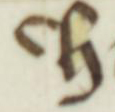|
| A |
 | Usage: caas
double compartment lower case 'a' is always used by this scribe. |  | Usage: A
e scribe has many different upper case 'A's. He might adopt one for use throughout a whole folio with little variation or he may use several versions on the same folio. |
 | Usage: And |  | Usage: Anoþer |
|
| D |
 | Usage: fond
this 'd' with open centre is a hallmark of this scribe. However, he can copy folio after folio with no sign of this type of 'd' but on other occasions, almost every 'd' is formed like this one. |  | Usage: hadde |
 | Usage: qd |  | Usage: Damyan
perhaps the scribe considered this to be an alternative to his normal upper case 'D'. |
|
| G |
 | Usage: right |  | Usage: wirchinge |
 | Usage: goode
the lower lobe of 'g' is sometimes squashed and the letter is not always completed. |  | Usage: heng
the scribe frequently puts a tag on 'g', 'f', and 't'. |
|
| H |
 | Usage: he
the tail-stroke of 'h' is neatly contained. |  | Usage: Than
Doyle and Parkes remark that the limb and tail-stroke of 'h' is often 'awkwardly tucked away'. |
 | Usage: þurgh
sometimes the tail-stroke is flicked out. |  | Usage: His
the scribe often adds the curved stroke to the left of the letter when it is upper case. |
|
| R |
 | Usage: daunger
long 'r' is frequently open from the bottom with hairline rising stroke. |  | Usage: right
modern 'r' is in the scribe's repertoire. |
 | Usage: gerles
'z'-shaped 'r' frequently has a curved tag issuing from the bottom left side of the body of the letter. |  | Usage: hir
modern 'r' with exaggerated flourish whose configuration is a characteristic feature. |
|
| S |
 | Usage: Erchedeknes
kidney-shaped 's' frequently used in final position. '8'-shaped 's' also used in final position. |  | Usage: scholde
long 's' used initially and medially although occasional use of sigma 's' in initial position. |
 | Usage: curs
final 8-shaped 's' with tag. The tag is an unusual feature of the hand but can be found occasionally. |  | Usage: browes |
|
| W |
 | Usage: wolde
the scribe's usual 'w' has the head of the central stroke standing above the strokes to left and right. 'w' almost always has two lobes at the right. |  | Usage: yelow
occasionally the left and middle strokes are of the same height. |
 | Usage: wole |  | Usage: Whan |
|
| Y |
 | Usage: fynch
'y' usually has a short tail as here and is frequently dotted. The scribe usually has a curving stroke above his 'i's. |  | Usage: concubyn
many 'y's are dotted. |
 | Usage: sodeinly
the scribe occasionally continues the tail of 'y' above the letter, sometimes actually crossing part of the graph. | | |
|
| S |
 | Usage: Sire
as with several of his upper case letters, the scribe has the simple version as here, but also adds single or double lines across the letter as a decorative feature, as in versions 2 and 3. |  | Usage: So |
 | Usage: Sompno(ur) | | |
|
| e |
 | Usage: Ther
the scribe's usual 'e' is neatly formed. |  | Usage: sowe
where 'e' is the final letter, it often has a tongue or tag. |
 | Usage: diocise |  | Usage: dede
similar formation of 'd' and 'e'. |
|
| I |
 | Usage: I
the length and curl of the head stroke may vary but upper case 'I' nearly always has a single lump on the left of the stem. |  | Usage: I |
 | Usage: In |  | Usage: In |
|
| N |
 | Usage: Ne
the classic shape of Scribe D's 'N'. It can be varied by the added decoration seen in versions 2-4. |  | Usage: Neither |
 | Usage: Now |  | Usage: Now
|
















































